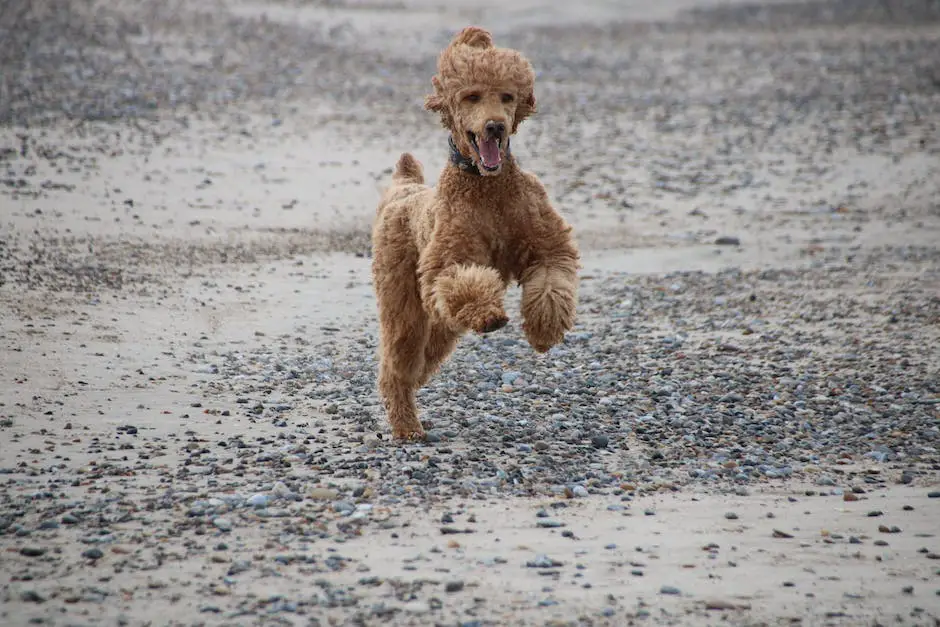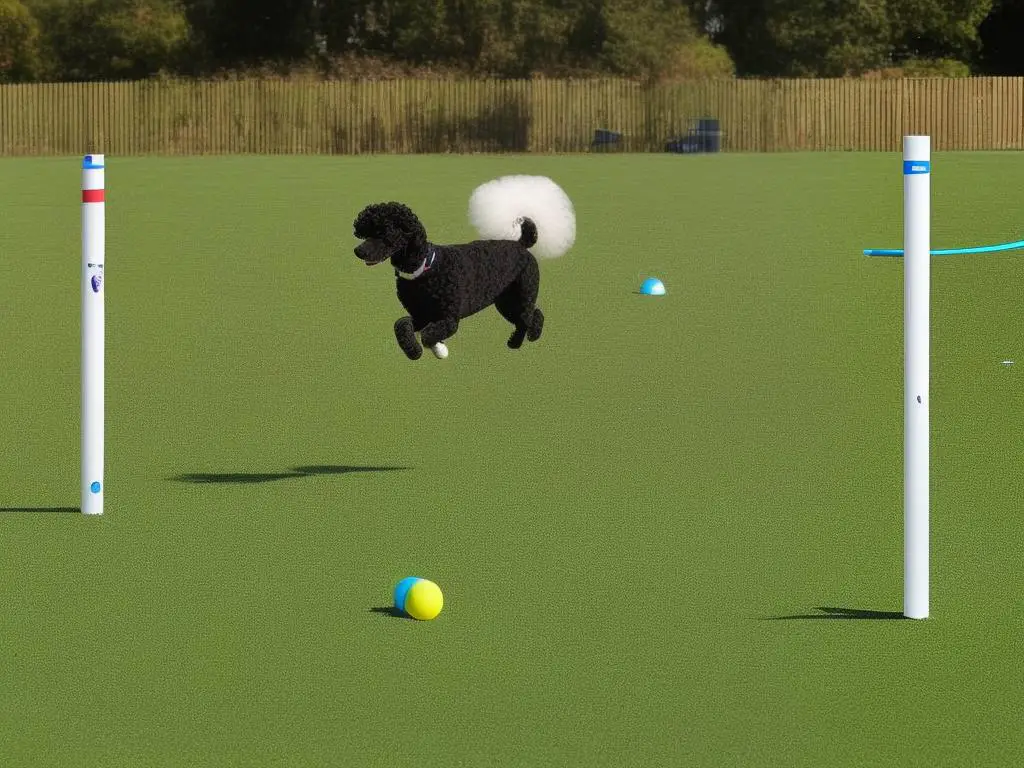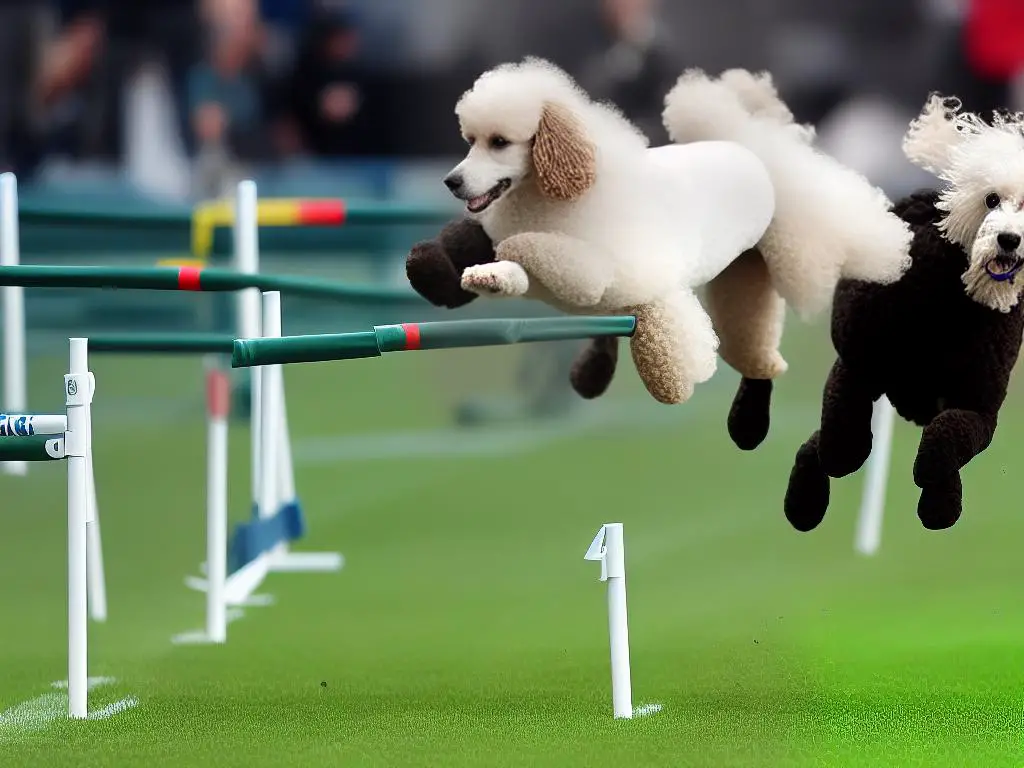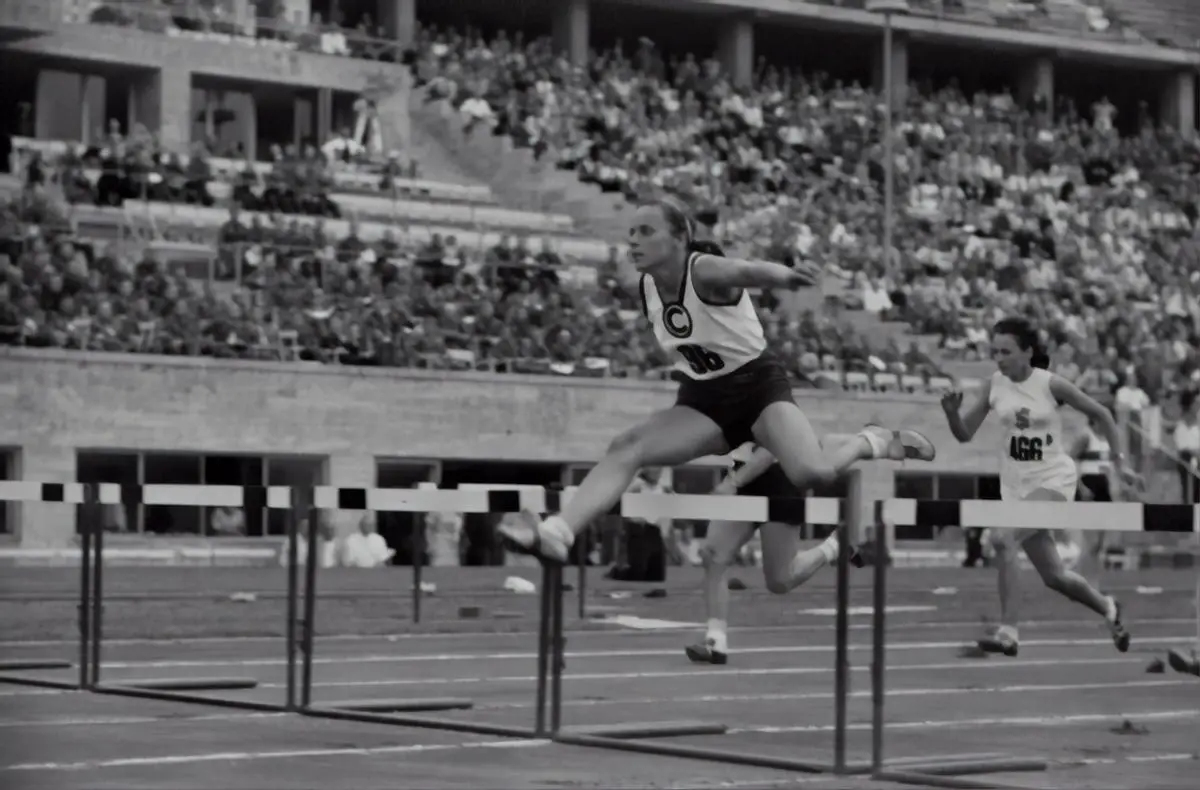Master Poodle Agility Training in Simple Steps
Welcome to the dynamic world of Poodle agility training, a thoroughly engaging sport that brings both the poodle and the handler intense joy, exercise, and teamwork. This labyrinth of leaps, turns, tunnels, and weaves is not just a game, it’s an opportunity to understand and connect with our poodles on a deeper level. To truly excel in this endeavor, it is imperative to not just familiarize with the agility sport but also to thoroughly comprehend the unique attributes of the breed involved: Our beloved Poodles. Their spirited personality, physical prowess, and eagerness to please make them naturally adept at agility. Furthermore, this essay will provide a thorough introduction to agility training and its various components, provide insights on establishing a productive training routine, and explore various techniques uniquely tailored for poodles.
Understanding Poodle Behavior and Physical Capabilities
Understanding Poodle Behavior
Poodles are renowned for their intelligence, learning capabilities, and lovable nature. Their highly inquisitive mind and robust physical health make them the prime candidate for agility training. They are classified into three categories based on size – standard, miniature, and toy poodles. All three types exhibit the same eagerness to please their humans, making them highly trainable.
A poodle’s temperament is typically lively, playful, and adventurous. They are ever-ready to participate in activities that stimulate their physical and mental vigor. Poodles are social animals, thriving in environments where they can communicate and interact extensively with their human guardians.
However, it’s essential to remember that every poodle possesses a unique personality. Some may be more perceptive and responsive than others, hence understanding your poodle’s individual personality traits is crucial to successful agility training.
Poodle’s Physical Capabilities
Physically, poodles are athletic dogs, with a robust structure that excellently supports agility training. With their lightweight yet durable build, they possess an extraordinary jumping ability that serves as a significant advantage in obstacle courses.
Beyond this physical prowess, poodles also have high stamina and speed. They’re capable of sustaining rigorous training sessions, and their fleet-footedness allows them to swiftly maneuver through agility courses. But keep in mind the abilities of a toy poodle may differ slightly from that of a standard or miniature poodle due to the size difference.
Poodle’s Eagerness to Please
Poodles have a strong eager-to-please attitude that stems from their deep bond with their human companions. This trait can dramatically enhance the agility training process. A poodle’s willingness to comply can simplify operations like commanding and guiding, making them more receptive to various agility training exercises.
Their desire to please also makes them susceptible to positive reinforcement. Rewards-based training typically results in higher success rates, as your poodle strives to replicate behaviors that had previously earned them a simple treat or words of praise.
Conclusion
To prepare your poodle for agility training, take the time to understand their behavior, physical abilities, and eagerness to please. Building a strong relationship based on mutual understanding and respect will help your furbaby excel in agility training and have fun while doing it. Moreover, respectful handling and positive reinforcement can be key components to training your poodle successfully. Remember, every dog is unique, and so, patience and consistency will be your best allies.

Introduction to Agility Training
Introduction to Agility Training: Setting The Stage For Your Poodle
Agility training is a fun and beneficial experience for both you and your poodle. Whether you want to take part in competitions or just enjoy a new activity with your pet, it can enhance your bond, give your dog an excellent mental and physical workout, and instill obedience and focus. This guide acquaints you with the basics of agility training, including standard rules, commands, and different types of typical obstacles.
Types of Agility Obstacles
Agility courses comprise various obstacles that your poodle must navigate. Here are the ones you’ll most commonly find during a competition:
- Tunnels: Tunnels are typically composed of sturdy fabric and formed in a tube shape. Your poodle will need to run straight through from one end to the other.
- Weave Poles: A series of evenly spaced poles that your poodle must weave through. The complexity of this obstacle develops your dog’s concentration and agility.
- Jumps: There are various types of jumps in the course like single jumps, double jumps, and tire jumps. Your poodle needs to jump over these without knocking them down.
Standard Rules in Agility Training
The rules of agility training can differ depending on the organizing body, but here are a few standard ones:
- Dogs are not permitted to wear any type of collar or lead during their run.
- Dogs must not skip any obstacles – every obstacle should be correctly navigated in the assigned order.
- Handlers must not touch their dog or the obstacles during the run.
- Knocking down jump bars, stepping-off contact obstacles prematurely, or missing weave poles will result in faults.
Using Commands In Agility Training
Commands are key in agility training. They help guide your dog through the course and improve their overall performance. Here are a few commands that are commonly used:
- “Over”: This command is used when you want your dog to jump over an obstacle.
- “Tunnel”: This signals your dog to run into and through a tunnel obstacle.
- “Weave”: Used to instruct your dog to weave through a series of poles.
- “Walk on/Go on”: This encourages your dog to keep moving forward on the course.
Focus on establishing these basic commands initially, and as your poodle becomes more advanced, you can incorporate additional commands for different obstacles.
Closing
The best way to succeed in agility training is with patience, positive reinforcement, and consistent practice. Remember, the primary goal is for both you and your poodle to have fun, so keep the sessions enjoyable and stress-free. Both you and your poodle will embark on a journey of learning and growth with agility training. Happy training!

Creating a Training Schedule and Environment
Understand the Importance of Consistent Training
The key to successful poodle agility training lies in consistency. Training your poodle on a regular basis leads to better performance in agility tests. Frequent repetition of exercises enhances your pet’s memory and physical coordination. It’s essential to remember that learning agility drills is a process that requires time, patience, and persistence.
Creating a Suitable Training Environment at Home
Your training sessions should commence in a safe and comfortable space for your poodle. Ensure that your chosen area at home is free of clutter or distractions that could impede your poodle’s focus and mobility.
Indoor areas with ample space, like living rooms or garages, can be appropriate for poodle agility training. However, an outdoor setting such as a fenced backyard would be more preferable. It facilitates a wider range of movement and mimics the outdoor nature of agility drills.
The essential kit for agility training consists of hurdles, weave poles, and tunnels. Ensure that all equipment is poodle-sized to be appropriate for your dog. Begin with simple, straightforward gear, and gradually introduce complex elements as your poodle becomes adept at maneuvering.
Develop a Regular Training Routine
Set a regular training schedule. Ideally, try to dedicate specific hours each day for training. This consistency helps your poodle settle into their training routine more comfortably.
At the beginning of the training phase, experiment with different durations for training sessions. The aim is to find the right balance where your poodle is neither undertrained nor overwhelmed. It’s crucial to take into account your poodle’s physical stamina. Training should be a fun, rewarding experience and not an exhausting ordeal.
Keep training sessions diverse and interesting. For instance, you could alternate between obstacle practice, running drills, and tricks. This varied approach will keep your poodle engaged and lessen the likelihood of boredom.
Tips to Keep Your Poodle Motivated
Poodles, like humans, perform better when they’re motivated. Integrating elements of fun and reward into your training routine can significantly boost your poodle’s performance. Here are some tips:
- Treats and Rewards: Use your poodle’s favorite treats as rewards. It teaches them to associate accomplishment of a task with a positive outcome, driving them to push harder during drills.
- Incorporate Playtime: This makes training enjoyable for your poodle. Try to incorporate toys or games that your pet loves into the training routine. You could also use playtime as a buffer between heavy agility drills.
- Positive Reinforcement: Always praise your poodle when they do well. Verbal encouragement in a happy tone goes long way in boosting their mood and eagerness to learn.
- Gradual Increase in Complexity: Level up the training only when your poodle is ready. Prematurely introduced complex drills might scare or confuse them. Let them master a level before progressing further.
Remember, the goal of poodle agility training is not just about creating a champion, but also about strengthening your bond with your poodle. Adopt an empathetic, patient, and loving approach to training. This will ensure your poodle makes impressive strides not just in agility drills, but also in their overall well-being.

Training Techniques for Poodles
The Agility of Poodles
Poodles, known for their pompous looks and fluffy hair, are more than just show dogs. In reality, they’re one of the most intelligent breeds and can be trained in all kinds of agility activities. With their surplus of energy, poodles are perfectly wired for agility training which involves navigating through various obstacles under the guidance of their human counterparts. The poodle’s agility, combined with their intelligence, makes them an obvious choice for agility training.
The Power of Positive Reinforcement
The foundation of successful poodle agility training lies with positive reinforcement. Positive reinforcement refers to the strategy of rewarding behavior you like, and ignoring behavior you don’t.
For example, each time your poodle successfully completes an agility task, give them a treat, play a game with them, or show them love through petting. This will encourage your poodle to repeat the desired behavior, in our case, agility tasks.
Mastering Voice Commands and Body Language
Voice commands play a significant role in poodle agility training. Vocal cues need to be clear, consistent, and succinct. Choose short, simple and distinct words like ‘Sit,’ ‘Stay,’ or ‘Go.’
Body language is another essential element in agility training. Dogs are incredibly attuned to our body language. Stand tall and straight to signal attentiveness, lean slightly forward to signal readiness, or lean slightly back to signal relaxation.
In agility training, it’s important to direct your poodle using both voice commands and body cues. For instance, when instructing your poodle to jump over an obstacle, point towards the obstacle while saying “Jump.”
Safety in Navigating Agility Obstacles
As important as enthusiasm and speed may be, safety is paramount in agility training. Start slow and gradually deal with more challenging obstacles. Aim to master one obstacle at a time. It’s important your poodle gets comfortable with each obstacle before moving onto the next.
For hurdles, start with the pole at the lowest height, gradually raising it as your poodle gets more confident. For tunnels, make sure the opening is wide and the tunnel is short. As your poodle becomes more comfortable, you can work with longer and narrower tunnels.
Teeter-totters or seesaws can be daunting for some dogs. You can introduce your poodle to this by making them walk on an evenly balanced plank before introducing the movement.
The Journey of Agility Training
Remember, making the agility training enjoyable for your poodle is crucial. This not only strengthens your bond with your pet, but also encourages them to learn and grow. Patience, time, and consistent practice are key in this exciting journey of agility training, but the payoff of a happier, healthier, and more disciplined poodle is well worth it.

Photo by austriannationallibrary on Unsplash
Mastering the art and sport of agility with your poodle is truly an enriching journey. Understanding your poodle’s physical capabilities, and their unique behavioral nuances can significantly bolster the training process. Learning and applying agility training fundamentals, establishing a regular and productive training schedule, and employing the right training techniques form the cornerstone of this journey. Each stride, jump, and weave in the agility course holds the potential to deepen your bond with your poodle. So, gear up, and step into this exciting adventure of agility training with your poodle.

